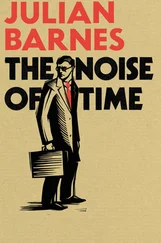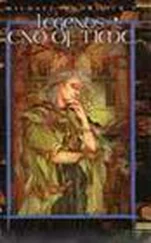VISION OF A TIMELESS UNIVERSE
Let me now give you my vision of quantum cosmology, contrasting it with the chronology of the universe (Figure 54), that temporal representation of the ‘thread’ in Figure 53. Every instant of time you can conceive of is somewhere in Platonia. But the instants of time can themselves be richly structured beyond imagination. All things we see around us now in the universe are just parts of instants of time. All over Platonia there exist instants of time in which Wagner is composing Tristan and Isolde , astronauts are repairing the Hubble Space Telescope, birds are building nests and I am baking bread. The wave function of the universe finds its way to very few of them. The structure of the wave function and the form of the laws of nature – in which the tendency of gravity to clump matter is surely vital – forces the blue mist to seek out the most special instants, strung out along delicate threads. I think it is wrong of cosmologists to call Figure 54 a chronology of the universe. It is the map of a footpath in Platonia. The blue mist shines at instants containing time capsules, all of which, in their different ways, tell stories of a journey from Alpha along a fine thread of ‘history’ – a path winding through Platonia. Time is in such instants since they reflect the story of the path and, since the structure of Platonia in its totality forces the universal wave function to ‘light up’ the paths, there is a sense in which these instants reflect everything that is.
However, whereas alpha particles create, through their tracks, a literal image of history, the time capsules of the real universe embody their stories in a much subtler manner. This is inevitable given the grandeur of the story – cosmology in its entirety. Consider, for example, the Sun. Quantum mechanically, it will need to be represented in a configuration space of, say, 10 60dimensions, but vast stretches of it will be virtually devoid of wave function. The mere fact that the Sun is roughly spherical and can be well modelled by the laws of stellar structure sweeps most of the configuration space clean of wave function. The particular abundances of the chemical elements within the Sun have the same effect, drastically limiting the region of the solar configuration space in which the blue mist is concentrated.
One configuration at which the blue mist does shine brightly will be a characteristic distribution of all the particles in the Sun. To an experienced astrophysicist, this distribution tells an immensely rich story stretching back to the first three minutes (in the standard picture) when the primordial hydrogen and helium abundances were established. The whole story of the cosmos that we call our own is written in the distribution of the Sun’s particles: the formation of galaxies and the earliest generations of stars; the supernova explosion that triggered the formation of the Sun and the solar system, and left the radioactivity that still powers so much tectonic and volcanic activity on the Earth; and the Sun’s steady burning of its nuclear fuel.
The decisive element in this picture is the seed – or rather, seeds – from which these stories can all grow by the penetration of the wave function into the nooks and crannies in Platonia where the configurations are coherent stories. The wave function can be present there only if it is entangled with the latent histories of a semiclassical wave function established at least somewhere in Platonia. These are the Hamiltonian ‘light rays’ from which everything must ‘grow’. Where are they likely to run, and what will their properties be? This is where the shape of Platonia must become decisive. The points in Platonia near Alpha containing Wagner and kingfishers are simply not visited by the blue mist, since Platonia as a whole lays out the latent histories in patterns that do not get entangled with such points.
Modern classical cosmology gives some hints as to where the latent histories might run. The simplest Big Bang cosmological solutions of Einstein’s equations, first discovered by the Russian mathematician Alexander Friedmann in the early 1920s, have the maximum degree of symmetry and therefore ascend the central line in Figure 53. This is the history distinguished in cosmology by the universe’s contents, despite the relativity of simultaneity. The universe explodes out of the singular state of zero volume, expands to a maximum volume and then recon-tracts to zero volume, gravity having halted and then reversed the initial, very rapid expansion. As shown schematically in Figure 55 (see p. 321), the universe ends in a Big Crunch. In other cosmological models, which normally require the universe to be spatially infinite, the expansion is so violent that the expansion is never halted.
In reality the universe is not completely symmetric, and the path out from Alpha is not exactly retraced, as shown in Figure 55, in which the rays emanating from Alpha are a measure of the relative ‘irregularity’ of the spatial configurations of the universe. Up the vertical ray, the universe is perfectly smooth, but on the rays that fan out at progressively larger angles the relative irregularity increases. The diagram shows one classical history which, at one end, starts in an almost perfectly smooth state but then becomes more and more irregular, due to the formation of galaxies, stars, black holes, planets and even human beings. This history reaches maximum expansion, turns round and recontracts, becoming more irregular all the time. It returns to the state of very small volume at a different point of Platonia, since although the volumes are small in both cases there are many additional variables that describe the structure of the state. Thus Alpha, the ‘end of Platonia’, is not a true point but actually a huge space of different possibilities, all with vanishingly small volumes.
Regarded purely as a path through Platonia, we cannot say that one end of this history is its beginning and the other is its end. I have lapsed into conventional talk. Such a priori notions do not belong in a timeless theory. Nevertheless, the two ends of the path are very different in nature, and it is tempting to say that, if our own existence is associated with such a path, its smooth end is what we would call the past and the irregular end the future. This would be very much in the tradition, initiated by Boltzmann, of suggesting that our sense of the forward flow of time, its arrow, is grounded solely in the increase in disorder that virtually all classical trajectories must exhibit if they pass through an exceptionally ordered region. Normally there are trajectories that both enter and leave such regions, and the entropic explanation of the arrow of time suggests that time will seem to flow forward in both directions out of these regions. In the present example, the exceptional region is on the frontier of Platonia, so the path truly ends there. This is beginning to look quite promising as the basis for a total explanation of time, but several conditions must be met. Before we address them, it is worth saying a little about gravity and thermodynamics.
The central conclusion of standard thermodynamics with an external time is that, if the low entropy of the world and its habitual increase are to be explained, the universe must presently be evolving out of a statistically most unlikely state. In systems in which gravity does not act, the unlikely state is generally one that is structured, while the likely state is characterized by a bland uniformity. Gas confined in a finite volume tends quickly to a very uniform state in which it occupies all the available space and all temperature differences are levelled out. This is the equilibrium state. It is vastly more probable than any ordered state because there are so many more ways in which it can be realized microscopically. The situation is much more complicated when gravity comes into play, since there is no well-defined equilibrium state for a gravitating system. Gravity is attractive, so a uniform state is unstable and will tend to break into self-gravitating clumps. This is the exact opposite of a gas.
Читать дальше












